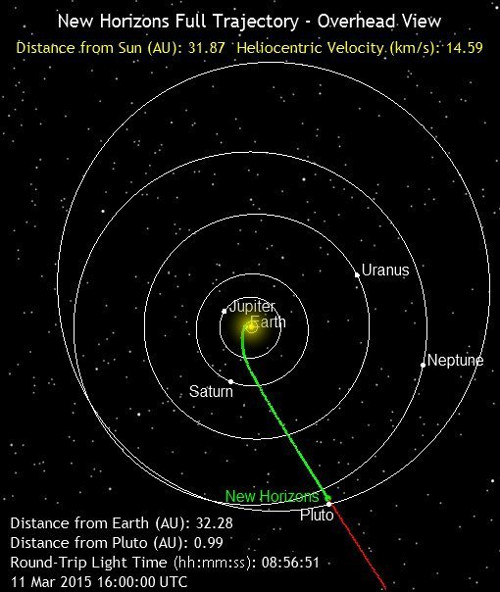While we wait for the Dawn spacecraft to come back around the lit side of Ceres as it continues a long period of orbital adjustment, let’s check in on two other spacecraft with the potential for a big science return. New Horizons performed a 93-second thruster burn on March 10 that was the farthest burn from Earth of any spacecraft in history. We’re now in the approach phase to Pluto/Charon and this was the first maneuver of that phase, designed to slow the spacecraft by a mere 1.14 meters per second. The New Horizons team describes this as ‘a tap on the brakes’ considering that the probe is moving at 14.5 kilometers per second.
As this New Horizons news update informs us, yesterday’s burn delayed arrival time at Pluto/Charon by 14 minutes, 30 seconds as the spacecraft’s course was adjusted. New Horizons is now 149 million kilometers from Pluto — in other words, 1 astronomical unit, or AU, meaning the spacecraft is the same distance from its target as the Earth is from the Sun. It takes a radio signal 4 hours, 28 minutes to reach us from New Horizons’ current position.

Image: This image shows New Horizons’ current position along its full planned trajectory. The green segment of the line shows where New Horizons has traveled since launch; the red indicates the spacecraft’s future path. Positions of stars with magnitude 12 or brighter are shown from this perspective, which is above the Sun and “north” of Earth’s orbit. Credit: New Horizons / JHU/APL.
Emily Lakdawalla has an excellent overview of the upcoming Pluto/Charon encounter, from which this note about data transmission:
Data will arrive on Earth in a series of downlinks. Downlink sessions can last as long as about 8 hours, but are usually somewhat shorter. Whenever New Horizons is downlinking data, it can’t take new photos, so the downlinks get shorter and less frequent as the spacecraft gets close to the time of the flyby, when it concentrates on collecting as much data as possible. Because data downlinks are slow, there will be much less data downlinked than New Horizons has stored on board. After data is downlinked, it must be processed before posting online. How long that will take is not yet known.
Near-Earth Asteroid Sample Return
Meanwhile, Japan’s Hayabusa 2 has just completed its initial checkout and evaluation, a process that has been ongoing since the spacecraft’s launch on December 3 of last year. Following on the original Hayabusa (MUSES-C) mission to the near-Earth asteroid 25143 Itokawa, Hayabusa 2 is likewise designed around a sample return, with arrival at the target asteroid 1999 JU3 in July of 2018. A year and a half of operations near the asteroid are to follow, with departure in December of 2019 and a return to Earth in December of 2020.
Like the Dawn spacecraft, Hayabusa 2 is powered by ion engines, which continue to prove their worth in precision maneuvering around such small objects. The sample collection procedure revolves around the Small Carry-on Impactor (SCI) that the spacecraft will deploy from a distance of 500 meters along with a camera. The SCI contains a 4.5 kilogram charge and a copper projectile that will strike the asteroid at 2 km/s. The camera will observe the explosion while Hayabusa 2 moves behind the asteroid. The plan is to take sub-surface samples from the resulting 1-meter crater from an asteroid known to be rich in carbon compounds.
1999 JU3 is an Apollo asteroid, one of a group of near-Earth objects that always bear watching because they have semi-major axes larger than Earth’s but perihelion distances less than Earth’s aphelion (the Chelyabinsk impactor, which struck the southern Urals with such spectacular effect in February of 2013, is believed to have been an Apollo-class asteroid). 1999 JU3 is also considered a more primordial asteroid than Itokawa. By taking samples from below the surface, researchers target materials less affected by solar radiation and exposure to space, thus offering a clearer view of the object’s chemical evolution.

Image: Relative locations of Hayabusa 2, Earth, Sun and 1999 JU3 as of March 3, 2015. Red grid shows plane of the ecliptic. Credit: JAXA.
According to JAXA, the Japanese space agency, Hayabusa 2 will burn its ion engines about 400 hours in March as it prepares for an eventual Earth flyby late this year, with a second period of engine operation in June. JAXA reports that the spacecraft is in good health and now moving to the cruise phase of the mission. With upgraded communications, navigation and attitude control systems and a small lander called MASCOT ( (Mobile Asteroid Surface Scout)) built by the German Aerospace Center in cooperation with the French space agency CNES, Hayabusa 2 should tell us much about the composition of this class of near-Earth asteroids, a population we’ll eventually investigate with human crews as we deepen our knowledge of nearby space.



Study shows Saturn moon Enceladus’ ocean may have hydrothermal activity:
http://phys.org/news/2015-03-saturn-moon-enceladus-ocean-hydrothermal.html
Never ceases to amaze me how they can finesse things so well that they are able to know how to properly “tap on the brakes” just enough to permit them to do what they want this craft to do. Amazing !
Thank you, Paul, for the Hayabusa 2 coverage. The original Hayabusa mission received far too little attention in the English language media. Truly, it was a robotic Apollo 13, full of drama and heroics from the indefatigable mission controllers. I have so much respect for JAXA’s never say die spirit in the face of adversity. The successful return of dust samples from Itokawa to Earth was a triumph.
Could the ‘tap on the brakes’ help adjust its course to intercept a KBO?
Major news as Enceladus is revealed to have warm ocean
http://www.nature.com/nature/journal/v519/n7542/full/nature14262.html
Implications are obvious here, we need a mission to this moon.